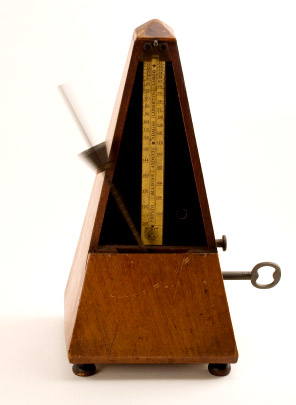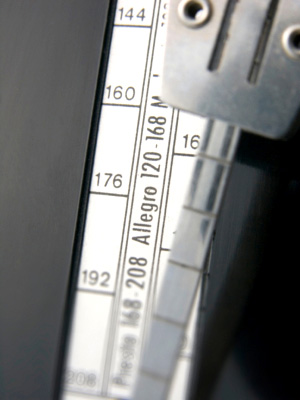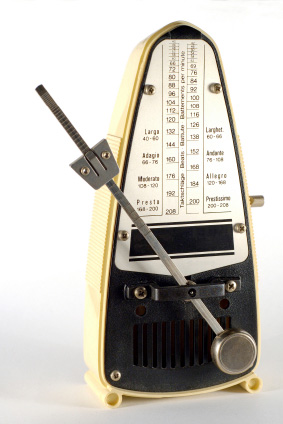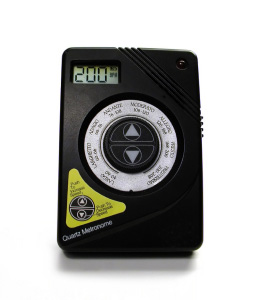What is a Metronome?
A "Metronome" is a device that can assist any musician with timing. It does this by emitting an audible pulse, such as 'tock-tock' type noise at regular intervals. These intervals are measured in Beats-per-Minute.
Firstly, a little bit of history. The metronome was invented by a Dutchman named Dietrich Winkle in the early part of the nineteenth century. In those days, it was a mechanical device, similar to the photo of the metronome on this page.
The well known composer Beethoven used a metronome and many of the worlds' great composers and musicians have got their timing exactly right, by using a metronome. Today, most persons learning the piano would use a metronome, which is also useful for those learning guitar, banjo and percussion instruments.

How does a Metronome work?
The mechanical metronome is a simple but very effective device. It is powered by a wind-up spring, rather like that in a clock - basically, it is a clockwork motor. When, the spring is wound tight using the key, it creates tension, which is the driving force for the vertical rod and adjustable weight.
When the metronome is set in motion, the rod swings back and forth, rather like a pendulum in a clock. The adjustable weight on the rod determines the rate of swing and thus the number of Beats-per-Minute. The weight is easily moved up and down the rod to adjust the speed. The close up photo on the right, shows the scale in BPM (Beats-per-Minute). The weight and rod is clearly visible, as is the horizontal engraving marks that determine the BPM.
As the weight is lowered on the rod, so it moves faster, increasing the BPM. Conversely, as the weight is raised, the rod moves slower. Each time the rod reaches the end of its travel, the metronome emits a 'tock' sound. It is quite loud and is deeper in pitch than the ticking of a clock.

Are there different types of Metronomes?
Metronomes come in a huge variety of types, colors and sizes. The photo at the top of this page depicts the original style of metronome, which was made of polished wood and operated by mechanical means only. These wonderful old metronomes are not only very useful, but also highly collectable in their own right!
There are a wide variety of electric metronomes. Many of these are battery powered and others actually plug in to the power. Being electric, means that the sound emitted can be varied greatly from the regular 'tock' sound that is associated with the mechanical version. Most electric or simple electronic units have the speed adjusted by a dial, knob or push button. The volume can also be increased or decreased, as can the tone.
Some electrical metronomes still retain the rod and weight as in the photo on the upper left. Others are pocket sized units that emit a pulsed sound, such as that shown on the lower left. There are even very sophisticated metronomes that not only provide a tempo in BPM, but also indicate the beats per measure (beats per bar of music). This is achieved by emitting a louder 'tock' sound at the beginning of each bar, followed by 3 quieter 'tocks' - as in the case of 4/4 time.
The latest types of metronomes are fully electronic and the best of these are completely digital! You can easily buy online! These types of metronomes not only feature the full range of BPM, in various tones and volumes, but also indicate the beats per measure for many different time signatures! They are great value and easy to use!
are fully electronic and the best of these are completely digital! You can easily buy online! These types of metronomes not only feature the full range of BPM, in various tones and volumes, but also indicate the beats per measure for many different time signatures! They are great value and easy to use!


How do I use a Metronome?
The metronome measures the 'tempo' of the music, which is in units of time known as Beats-per-Minute (BPM). This could range from less than 20 BPM to more than 200 BPM! The box on the left explains the more common Tempo marks that you might see in music. A 'normal' tempo is around 100 BPM - that's one beat about every 2/3 of a second.
Once the tempo speed is determined and the metronome set in action, it is only a matter of playing the piano (or guitar etc.) and maintaining the same play rate (tempo) as the metronome. At first, this may seem quite easy, but in fact it takes a reasonable amount of practice to accurately maintain a given tempo - particularly fast tempos. This is reason why using a metronome is so valuable, as it teaches the player to recognize various tempos, as well as training the player in rhythm.
A metronome that also indicates beats per measure, or beats in the bar, is invaluable. Not only does this type of unit train the player in tempo, but also to play the correct rhythm, such as 4/4 (common) time, 3/4 (waltz time) and a huge variety of other regular and irregular time signatures.
Learning to recognize and maintain a particular tempo, is vital to successfully playing piano by ear. Being able to pick up a tempo and rhythm for any piece of music, is what differentiates an ordinary player from a pianist. I recommend you get a metronome - you'll be amazed!





How much do Metronomes cost?
What's the best one to buy?
You could expect to pay around $20 - $50 for a reasonable quality modern metronome. These would generally be electric audible types with a pendulum, or fully electronic pulse types. More sophisticated units with beat control and sub divisions could cost upwards of $100.
Some traditional mechanical metronomes are still made and you could expect to pay about $150 for these. The older mechanical models are now becoming rare and prices vary wildly. For a good quality antique, you could expect to pay many hundreds of dollars.
The best deal to start off with, is to purchase a digital unit online. The Metronome that I like is under $30 and is fully featured. It probably represents the best value anywhere.
The Metronome that I like is under $30 and is fully featured. It probably represents the best value anywhere.
Make Your Own "Beats"!
Every now and then, I come across something that is truly 'music to my ears'!
Have you ever thought about making your own beats and music? Sure - if you have a recording studio or plenty of money. BUT - this is different, at a fraction of the price...
A full Digital Audio Workstation. Create rap, hip hop, gospel, dance and more, with sounds, keyboard, and drums. Best of all, your level of experience doesn't matter. You'll love it!
Have you ever thought about making your own beats and music? Sure - if you have a recording studio or plenty of money. BUT - this is different, at a fraction of the price...
A full Digital Audio Workstation. Create rap, hip hop, gospel, dance and more, with sounds, keyboard, and drums. Best of all, your level of experience doesn't matter. You'll love it!
What is Rhythm and Beat?
Rhythm and Beat go hand in glove to express the way and feeling that music is played.
Rhythm is the measure of time and is basic to all music. It is actually divided up to convey the feeling of the music. This is indicated by the speed, or the number of beats per minute.
Beat is frequently referred to as the number of pulses in a music 'measure'. 4 beats to the measure or 4/4 time is most common. 3/4 is known as waltz time. There are many regular and irregular beats.
A metronome is an invaluable tool for every musician.
What is Tempo?
Tempo is broadly described as the timing or speed that a piece of music is played. The speed is denoted in Beats-per-Minute, or BPM. Sometimes the bpm is actually written at the beginning of the music. It is denoted as: (music note) = 120. This means the piece is played at 120 bpm.
The tempo signature is generally written in Italian. In addition to speed, tempo can also inform about the 'feeling' of the music as well as indicate when to speed up or slow down.
The box below gives the most common forms of tempo, together with their bpm.
Tempo Signatures
Listed below are the most common Tempo signatures.
Largo:
Very slow 40-60 bpm
Adagio:
Slow and stately 70-80 bpm
Andante:
Walking pace 80-100 bpm
Moderato:
Moderately 100-120 bpm
Allegro:
Fast, bright 120-160 bpm
Presto:
Very fast 160-200 bpm
Check out these Metronomes!
Just imagine have a metronome that is fully featured and easy to use.
A visual and audible beat indicator over the complete timing range. Choose from a range of cool sounds, for either accent or beat.
Practice any time signature, 9/8, 5/4 or whatever! Best of all, there are many great features, which allow you to practice at an increasing or decreasing tempo.
A visual and audible beat indicator over the complete timing range. Choose from a range of cool sounds, for either accent or beat.
Practice any time signature, 9/8, 5/4 or whatever! Best of all, there are many great features, which allow you to practice at an increasing or decreasing tempo.
Metronomes

